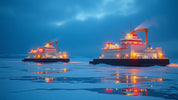
Russia's Floating Nuclear Power Plants: Revolutionizing Energy in the Arctic and Beyond
, by Unboxify, 4 min reading time

, by Unboxify, 4 min reading time
On May 22nd, 2020, after 13 years of construction, the Akademik Lomonosov went into full operation, marking a major milestone as the world's only floating nuclear power plant. This groundbreaking venture has sparked curiosity and debate. Why is Russia spearheading this novel energy solution? What strategic advantages do such floating nuclear facilities offer?
Utilizing nuclear power at sea is not a new concept. It has been a critical technology for military use, offering enormous strategic benefits:
Unlike military counterparts, the Akademik Lomonosov isn't a warship and does not use nuclear energy for propulsion. Instead, it is a floating power plant designed to produce electricity for up to 200,000 people. This isn't an entirely novel idea:
The Akademik Lomonosov comprises two KLT-40 naval propulsion reactors (also used in Russian icebreakers) and can provide up to 70 megawatts of electricity. Heat generated during nuclear fission can also be used for district heating.
The design and operation of these floating plants offer several strategic benefits:
The Akademik Lomonosov was completed in Saint Petersburg before being towed to Murmansk where it was outfitted with nuclear fuel elements and prepped for its journey to Pevek, north of the Arctic Circle.
The diminishing sea ice in the Arctic is unlocking new opportunities for Russia. Data since 1978 shows a decline in polar sea ice, facilitating access to northern oil and gas deposits. Russia is keen to exploit the Northern Sea Route, a shorter connection between Europe and Asia, with significant plans in place:
In this strategy, floating nuclear power plants are pivotal, with state energy company Gazprom planning to use five of these plants for offshore drilling platforms on the Kola and Yamal peninsulas.
Nuclear energy remains a contentious issue worldwide, especially after catastrophic events like Chernobyl in 1986 and Fukushima in 2011. While some nations are phasing out nuclear technology, others, like Russia, see it as crucial for:
Russia's floating nuclear power project has its critics, who point to potential risks such as vulnerability to natural disasters like tsunamis and past incidents like a radioactive leak on a Russian nuclear icebreaker in 2011. Despite these concerns, project operators assure that all risks have been assessed and dangers ruled out.
China is also eyeing this technology, indicating that floating nuclear power plants might become more common in the coming decades. As nations seek solutions for bridging energy transition periods or boosting energy security in remote regions, floating nuclear plants could provide a viable option.
Russia's investment in floating nuclear power plants marks a significant step in utilizing nuclear technology for civilian purposes. Amidst global warming and geopolitical shifts, the flexibility and strategic advantages offered by these plants may well dictate their proliferation across the world. As we move towards a future of diverse energy requirements, the Akademik Lomonosov could be the harbinger of a new era in nuclear energy utilization.







